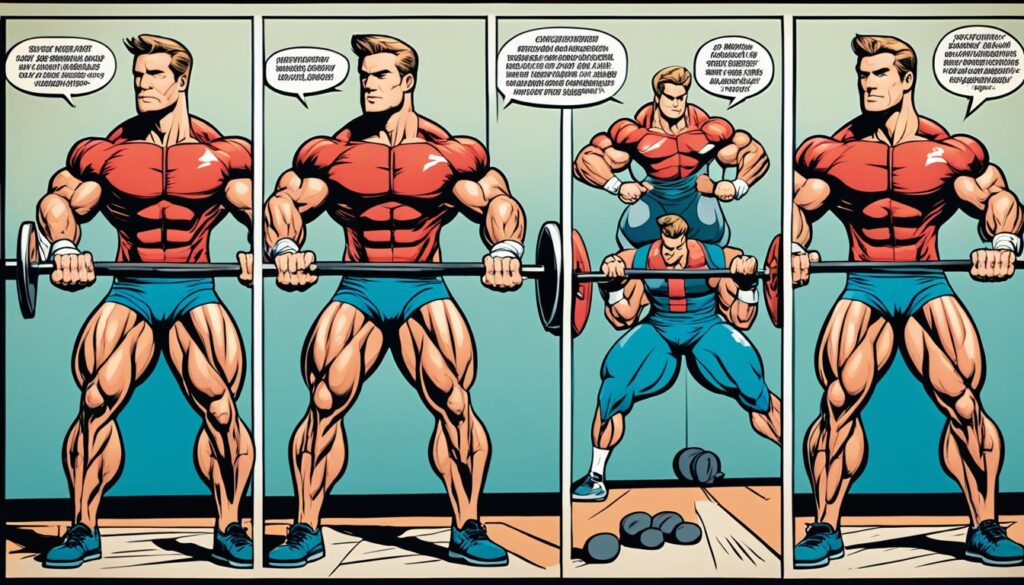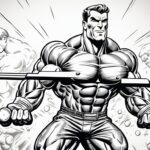The Benefits of deadlift muscle groups
In this article, I will explore the incredible benefits that deadlift muscle groups can bring to your fitness journey. By targeting multiple muscle groups simultaneously, deadlifts can help enhance strength, build muscle, and sculpt your physique.
Key Takeaways:
- Deadlifts target multiple muscle groups, making them a highly efficient exercise.
- They primarily work the muscles in your lower body, including the glutes, hamstrings, quads, and calves.
- Deadlifts also engage other muscles, such as your back, core, and forearms.
- Women can benefit greatly from including deadlifts in their fitness routine, as they promote lean muscle growth and a more sculpted physique.
- Variations of deadlifts, such as close grip and Romanian deadlifts, allow you to target specific muscle groups.
Now, let’s delve deeper into the benefits of deadlift muscle groups and how they can transform your fitness journey.
Understanding the Deadlift Exercise
Before diving into the benefits, it’s important to understand the deadlift exercise itself. Deadlifts are a compound movement that primarily targets the muscles in your lower body, including your glutes, hamstrings, quads, and calves. However, they also engage a variety of other muscles, such as your back, core, and forearms.
Deadlifts can be performed using various equipment, including barbells, dumbbells, or kettlebells. This versatility allows you to choose the equipment that best suits your preferences and fitness level. Whether you prefer the stability and grip strength challenge of a barbell or the convenience and unilateral training potential of dumbbells, you can still reap the benefits of deadlifts.
“Deadlifts are one of the most effective exercises for targeting multiple muscle groups and building overall strength.” – Fitness Expert
In addition to targeting a wide range of muscles, deadlifts also activate your central nervous system, making them a highly efficient exercise for improving both strength and power. By incorporating deadlifts into your fitness routine, you can enhance your performance in other exercises and daily activities.
Now that you have a better understanding of the deadlift exercise and its ability to engage multiple muscle groups, let’s explore the specific benefits it offers in the next section.
Deadlift Muscle Groups for Women
Deadlifts are a fantastic addition to any fitness routine for women. They not only strengthen the lower body but also help improve overall body composition. Many women shy away from heavy weightlifting, fearing they will become bulky. However, deadlifts engage multiple muscle groups, promoting lean muscle growth and increasing metabolic rate, leading to a more sculpted physique.
When women incorporate deadlifts into their fitness routine, they target various muscle groups simultaneously, making the exercise highly efficient and effective. The primary muscles worked during deadlifts include:
| Muscle Group | Description |
|---|---|
| Glutes | The gluteus maximus, medius, and minimus are activated to a great extent, helping to shape and lift the buttocks. |
| Hamstrings | The muscles at the back of the thighs, such as the biceps femoris, semitendinosus, and semimembranosus, are heavily involved, developing strength and definition. |
| Quadriceps | The quadriceps, including the vastus lateralis, vastus medialis, vastus intermedius, and rectus femoris, play a significant role in extending the knee joint during the deadlift movement. |
| Calves | The gastrocnemius and soleus muscles in the calves provide stability and contribute to the overall strength required for this exercise. |
| Erector Spinae | The muscles that run along the spine, including the spinalis, longissimus, and iliocostalis, are activated during deadlifts, promoting back strength and stability. |
| Core | The core muscles, including the rectus abdominis, transversus abdominis, and obliques, are engaged to maintain proper form and stability throughout the movement, strengthening the midsection. |
| Forearms | The muscles in the forearms, such as the flexor digitorum profundus and flexor digitorum superficialis, are worked to grip and hold onto the weight during deadlifts. |
By targeting these muscle groups, deadlifts provide a well-rounded workout that not only enhances physical strength but also contributes to improved posture, stability, and overall functional fitness. The combination of lower body strengthening and full-body engagement makes deadlifts an excellent exercise for women looking to build a strong and toned physique.
“Deadlifts are a compound movement that activate numerous muscle groups simultaneously, allowing women to efficiently achieve their fitness goals and transform their bodies.” – Fitness Expert
Contrary to popular myths, deadlifts do not make women bulky. Instead, they help build lean muscle mass, defining the body and enhancing overall shape. Additionally, the metabolic demand of deadlifts leads to an increase in calorie expenditure, aiding in weight management and fat loss. Incorporating deadlifts into a well-rounded fitness routine can empower women to achieve their desired goals and experience the transformative benefits of this powerful exercise.
Variations of Deadlifts to Target Muscle Groups
To target specific muscle groups or add variety to your routine, there are several deadlift variations you can incorporate. Deadlifts are an excellent compound exercise that engages multiple muscle groups simultaneously. By experimenting with these variations, you can tailor your deadlift routine and target specific muscle groups for maximum results.
Close Grip Deadlifts
Close grip deadlifts are a variation of the traditional deadlift where you place your hands closer together on the barbell. This grip shifts the focus onto your quads, providing a deeper burn in the front of your thighs. By engaging your quads, close grip deadlifts contribute to overall leg strength and development.
Romanian Deadlifts
Romanian deadlifts primarily target the hamstrings, making them an ideal variation for hamstring development. In this variation, you perform the deadlift with a slight bend in the knees and focus on pushing your hips back while maintaining a neutral spine. Romanian deadlifts help strengthen the posterior chain, including the glutes and lower back.
Weighted Deadlifts
Adding weight to your deadlifts is an effective way to increase the challenge and stimulate muscle growth. You can incorporate dumbbells or barbells to perform weighted deadlifts. By progressively increasing the weight over time, you continually challenge your muscles, leading to greater strength and muscle development.
Sumo Deadlifts
Sumo deadlifts are a wide stance variation of the deadlift that engages your inner thighs and glutes. By positioning your feet wider than shoulder-width apart and gripping the barbell with a wider grip, you activate different muscle groups compared to traditional deadlifts. Sumo deadlifts can help improve hip mobility and develop strong, toned inner thighs.
| Deadlift Variation | Muscle Group Targeted |
|---|---|
| Close Grip Deadlifts | Quads |
| Romanian Deadlifts | Hamstrings, Glutes, Lower Back |
| Weighted Deadlifts | Full Body, Overall Strength and Muscle |
| Sumo Deadlifts | Inner Thighs, Glutes |
By incorporating these deadlift variations into your routine, you can effectively target specific muscle groups and add variety to your workout. Remember to maintain proper form and gradually increase weights to avoid injury and maximize results.

Building Strength and Muscle with Deadlifts
Deadlifts are not only great for muscle growth but also for building strength. As a compound movement, they require multiple muscle groups to work together, resulting in functional strength gains. By progressively increasing the intensity of your deadlift routine over time, you can continuously challenge your muscles and stimulate growth. Incorporating deadlifts into your fitness routine, along with proper nutrition and recovery, can lead to significant strength and muscle development.
When you perform a deadlift, you activate several deadlift muscle groups simultaneously, including:
- Your lower body muscles: glutes, hamstrings, quads, and calves
- Your back muscles: erector spinae, latissimus dorsi, and trapezius
- Your core muscles: rectus abdominis, obliques, and transverse abdominis
- Your forearm muscles: brachialis, brachioradialis, and flexor digitorum profundus
This full-body activation makes deadlifts an efficient exercise for building overall strength. Additionally, deadlifts engage the posterior chain, which includes the muscles along the back of your body, from your neck to your heels. Strengthening the posterior chain not only enhances your ability to perform daily tasks but also contributes to improved posture and stability.
One of the key factors in building strength and muscle with deadlifts is incorporating weighted resistance. Adding weight to your deadlifts, whether through dumbbells or barbells, increases the challenge and stimulates muscle growth. Start with a weight that allows you to maintain proper form and gradually increase the resistance as you build strength.
Remember, consistency is key when it comes to developing strength and muscle. Aim to include deadlifts in your routine at least two to three times per week. This consistency will allow your body to adapt and progressively increase the demands placed on your muscles.
Here’s an example of a deadlift routine that you can follow to build strength and muscle:
| Exercise | Sets | Reps | Rest |
|---|---|---|---|
| Deadlift | 4 | 8-10 | 2-3 minutes |
| Romanian Deadlift | 3 | 10-12 | 1-2 minutes |
| Sumo Deadlift | 3 | 8-10 | 2-3 minutes |
| Single-Leg Deadlift (each leg) | 3 | 10-12 | 1-2 minutes |
Remember to prioritize proper form and technique when performing deadlifts. If you’re new to deadlifting, it’s always a good idea to seek guidance from a qualified fitness professional to ensure you’re using correct form and avoiding potential injuries.
Incorporating deadlifts into your routine can take your strength and muscle development to the next level. Challenge your muscles, progressively increase your resistance, and enjoy the transformative effects that deadlifts can have on your overall fitness.
Conclusion
Deadlifts are a powerhouse exercise that target multiple muscle groups simultaneously, making them a valuable addition to any fitness routine. By incorporating deadlifts into your workouts, you can enhance strength, build muscle, and sculpt your physique.
Whether you’re a beginner or a seasoned lifter, unlocking the benefits of deadlift muscle groups can take your fitness journey to new heights. Start incorporating deadlifts into your routine and witness the transformative effects they can have on your overall fitness.
With deadlifts, you can strengthen your lower body muscles, including your glutes, hamstrings, quads, and calves. Additionally, deadlifts engage other muscles such as your back, core, and forearms, resulting in a full-body workout.
To target specific muscle groups or add variety to your routine, you can experiment with variations such as close grip deadlifts, Romanian deadlifts, and sumo deadlifts. Remember, progressive overload is crucial for stimulating muscle growth and building strength.
FAQ
What are the benefits of deadlift muscle groups?
Deadlift muscle groups provide incredible benefits for your fitness journey. They enhance strength, build muscle, and help sculpt your physique by targeting multiple muscle groups simultaneously.
What muscles are targeted in the deadlift exercise?
The deadlift exercise primarily targets muscles in your lower body, including your glutes, hamstrings, quads, and calves. It also engages other muscles such as your back, core, and forearms.
Are deadlifts suitable for women?
Absolutely! Deadlifts are a fantastic addition to any fitness routine for women. They not only strengthen the lower body but also help improve overall body composition. Deadlifts engage multiple muscle groups, promoting lean muscle growth without bulky physique concerns.
What variations of deadlifts can target specific muscle groups?
To target specific muscle groups or add variety to your routine, you can incorporate variations such as close grip deadlifts for your quads, Romanian deadlifts for hamstrings, weighted deadlifts for increased challenge, and sumo deadlifts for inner thighs and glutes.
How do deadlifts help in building strength and muscle?
Deadlifts are excellent for building strength and muscle. As a compound movement, they require multiple muscle groups to work together, resulting in functional strength gains. By gradually increasing the intensity of your routine, you can continuously challenge your muscles for growth.
